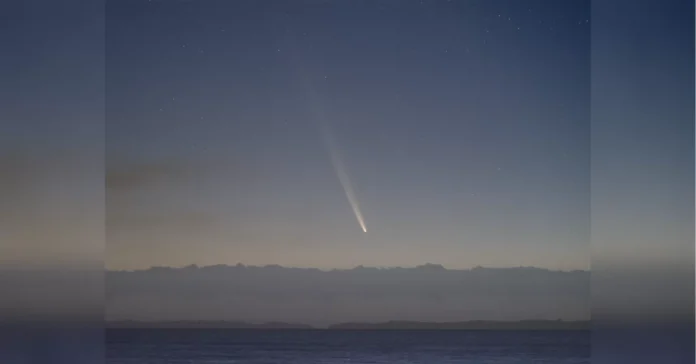In the middle of October, a spectacular event will take place in the night sky. A comet will make its closest approach to Earth, giving us a rare opportunity to witness its beauty. But that’s not all, towards the end of the month, we will also be treated to the annual Orionid meteor shower. It’s a double celestial treat that you won’t want to miss!
Let’s start with the comet. Named after the discoverer, astronomer Michael Mattiazzo, Comet Mattiazzo will make its closest approach to Earth on October 10th. This comet was first discovered in March of this year and has been steadily brightening as it makes its way towards the inner solar system. But what makes this comet special is its trajectory. It will pass just 6.8 million miles from Earth, making it one of the closest comet approaches in recent years.
Comets are often referred to as «dirty snowballs» because they are made up of ice and dust. As they approach the sun, the ice starts to melt, releasing gas and dust. This creates a beautiful tail that can stretch for millions of miles. Comet Mattiazzo’s tail is expected to be quite long, making it a stunning sight in the night sky. With a pair of binoculars or a small telescope, you may even be able to see the comet’s nucleus, the solid part of the comet that remains intact.
The best time to view Comet Mattiazzo will be in the early hours of the morning, just before dawn. It will be visible in the southern sky, near the constellation of Aquarius. If you live in a city with light pollution, try to find a dark spot away from the city lights for the best view. And don’t forget to bundle up, as October nights can be chilly.
But the excitement doesn’t end there. Towards the end of the month, we will be treated to the annual Orionid meteor shower. This meteor shower is known for its fast and bright meteors, which are caused by debris from Halley’s Comet. The peak of the Orionids will be on October 21st and 22nd, with up to 20 meteors per hour visible in the night sky.
To view the Orionids, you don’t need any special equipment. Simply find a dark spot with a clear view of the sky and let your eyes adjust to the darkness. The best time to view the meteors will be after midnight, when the constellation of Orion rises in the eastern sky. The meteors will appear to radiate from the direction of Orion’s belt, making them easy to spot.
The Orionids are named after the constellation of Orion, as this is where the meteors appear to originate from. In Greek mythology, Orion was a hunter who was killed by a scorpion. The gods placed him in the sky as a constellation, and every year, we are treated to a beautiful meteor shower in his honor.
So why should you make the effort to view these celestial events? For one, they are incredibly rare and only happen once a year. It’s a chance to witness the wonders of our universe and be reminded of how small we are in the grand scheme of things. It’s also a great opportunity to bond with friends and family, as stargazing can be a fun and educational activity for all ages.
In addition, viewing these celestial events can be a humbling experience. It’s a reminder that we are all connected to the vastness of the universe and that there is so much more to explore and discover. It’s also a reminder to appreciate the beauty of our planet and the importance of preserving it for future generations.
So mark your calendars for the middle and end of October and don’t miss out on this double celestial treat. Whether you’re a seasoned stargazer or someone who has never looked up at the night sky, take the time to witness these spectacular events. You won’t regret it.

